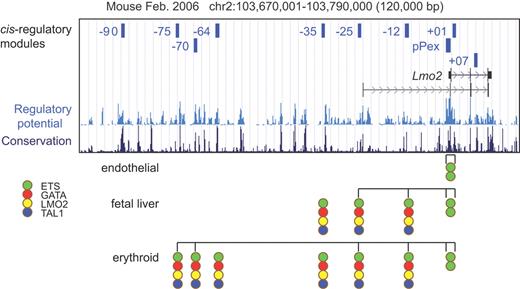Finding gene regulatory regions and unraveling their interactions to understand tissue-specific expression are formidable challenges. Landry et al combine multiple approaches to successfully predict regulatory regions, and then show that the discovered enhancers do not work alone, but rather they work with partners to define specific patterns of expression.
Research over the past half century has shown that normal organismal development proceeds by a tightly regulated program of differential gene expression. When that regulation is lost, bad things happen. One example of considerable interest to hematologists is the ectopic expression of Lmo2 in T cells, which leads to leukemia in some patients undergoing stem cell gene therapy regimens. Finding the DNA sequences and proteins that regulate gene expression remains a difficult challenge, but the new work from Landry and colleagues illustrates beautifully how a combination of comparative genomics and high-throughput biochemistry can identify these components efficiently.1 The authors examine a 250-kb region surrounding the Lmo2 gene, which is needed for hematopoiesis and vascular endothelial remodeling. They first identify17 noncoding sequences conserved from mice to marsupials, and then selected 11 with high levels of histone acetylation (assayed by hybridization of chromatin-immunoprecipitated DNA to custom microarrays) for direct functional tests in transgenic mice. From these candidates, Landry et al identify a proximal promoter, a distal promoter, and 8 distal enhancers (see figure). This is a remarkably high success rate for predictions of cis-regulatory modules (CRMs). Some of these had been predicted from previous studies,2-4 but these earlier predictions also included several false positives. Searching for signatures of both evolutionary selection and histone modification–associated regulation led to more reliable predictions.
Prediction and validation of cis-regulatory modules for Lmo2. CRMs were predicted both by their conservation from mouse to the marsupial opossum (a measure of sequence constraint is shown on the last line of the locus map) and by peaks of acetylation of histone H3 in the chromatin. The CRMs with demonstrable activity in transgenic mice are shown as blue boxes on the first group of lines on the map (pPex is the extended proximal promoter), followed by the locations of introns and exons of the Lmo2 gene and a distal promoter. The regulatory potential3 score (light blue data track) has peaks in most of the CRMs, but some noncoding regions with strong constraint and regulatory potential are not active in the transgenic mouse assay. Below the locus maps is a summary of the occupancy of the CRMs by transcription factors and the pattern of expression that they regulate. See the complete figure in the article beginning on page 5783.
Prediction and validation of cis-regulatory modules for Lmo2. CRMs were predicted both by their conservation from mouse to the marsupial opossum (a measure of sequence constraint is shown on the last line of the locus map) and by peaks of acetylation of histone H3 in the chromatin. The CRMs with demonstrable activity in transgenic mice are shown as blue boxes on the first group of lines on the map (pPex is the extended proximal promoter), followed by the locations of introns and exons of the Lmo2 gene and a distal promoter. The regulatory potential3 score (light blue data track) has peaks in most of the CRMs, but some noncoding regions with strong constraint and regulatory potential are not active in the transgenic mouse assay. Below the locus maps is a summary of the occupancy of the CRMs by transcription factors and the pattern of expression that they regulate. See the complete figure in the article beginning on page 5783.
Many CRMs have been characterized by one major function, a promoter or an enhancer that increases expression in a particular tissue. Genes expressed in multiple tissues can have a specific enhancer for each tissue. Landry et al show that Lmo2 is regulated in a different way—combinations of CRMs are needed to specify a pattern of expression. The extended proximal promoter directs strong expression in endothelial cells. However, when this promoter is combined with a set of distal enhancers, the gene is expressed in fetal liver and erythroid cells (see figure). Transcription factors of the ETS family (SFPI1 and FLI) are bound to the proximal promoter, and additional transcription factors with roles in hematopoiesis (TAL1, LMO2, and GATA2 factors) are bound to the distal CRMs. However, no single enhancer specifies erythroid expression. Just as multiple approaches improve predictions of CRMs, it takes more than one CRM to expand the expression of Lmo2 into hematopoietic tissues.
Conflict-of-interest disclosure: The author declares no competing financial interests. ■
REFERENCES
National Institutes of Health


This feature is available to Subscribers Only
Sign In or Create an Account Close Modal